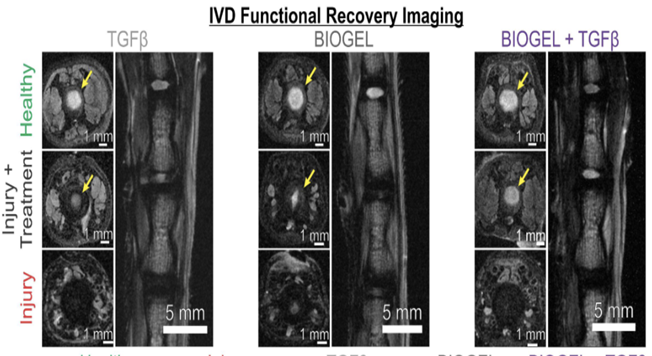
 IVD recovery imaging which demonstrates the efficacy and regeneration capability of the BIOGEL loaded with TGFB
IVD recovery imaging which demonstrates the efficacy and regeneration capability of the BIOGEL loaded with TGFB
Invention Summary:
Intervertebral disc degeneration (IVD) is the leading cause of back pain amongst humans and is a precursor to more severe conditions.
To address this issue, a team led by Rutgers scientists have developed a novel injectable hydroGEl technology to address IVD. In brief, the hydroGEL is composed of succinylated gelatin-tetrazine and succinylated gelatin-norbornene and loaded with a TGFb growth factor. After the succinylated gelatin solution is mixed, a solid fibrous hydrogel forms, mimicking the biomechanical properties of soft tissues found in the human body, is formed within five minutes at the site of injection and is unaffected by biological surroundings. Current IVD repair methods utilize surgical procedures which expose patients to greater risk. This injectable hydrogel aims to fill the unmet commercial need for injectable hydrogels, ultimately reducing additional tissue damage, surgical incisions, and biological interference.
Market Applications:
- Accelerating damaged tissue regeneration specifically for intervertebral disc (IVD) pathologies.
- 3D stem cell culture (Neurogenesis).
- The intervertebral disc (BIOGEL-IVD) and spinal cord (BIOGEL-SCI) regeneration.
- Carrier vehicle for sensitive payloads such as growth factors and small molecules.
Advantages:
- Improved tissue repair efficacy & minimal biological interference.
- Reduced stress load (pain).
- Injectable and solidifies in ~5min.
Intellectual Property & Development Status: Patent pending. Available for licensing and/or search collaboration. For any business development and other collaborative partnerships contact: marketingbd@research.rutgers.edu